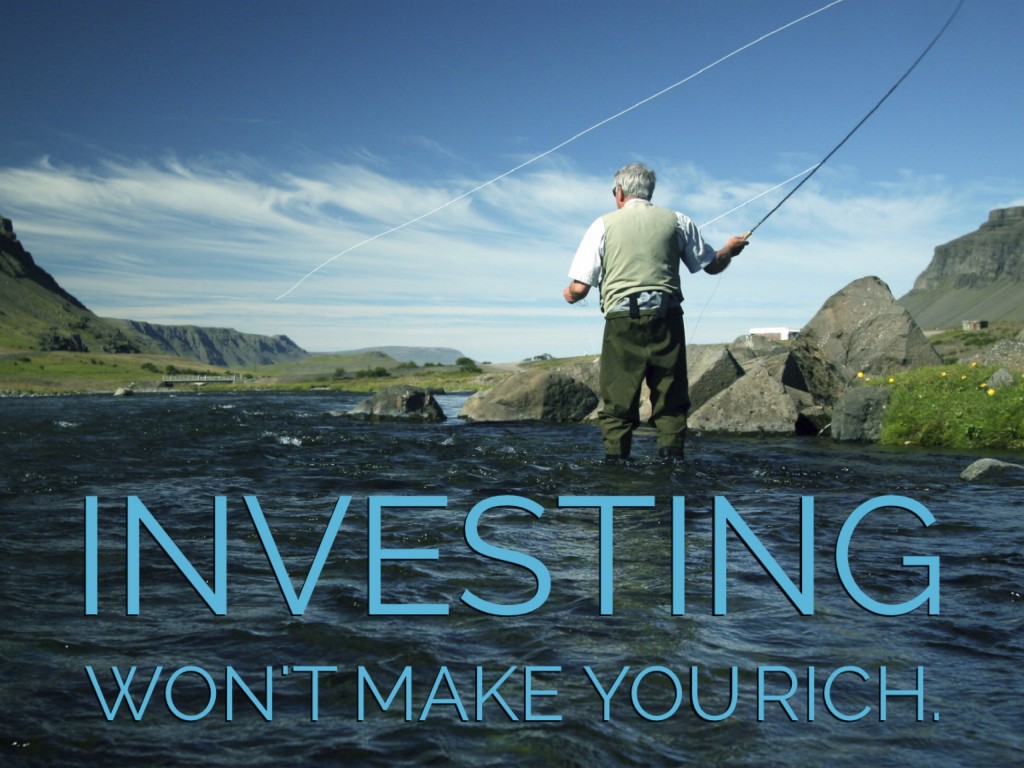The primary role of investing is to preserve your wealth not grow it. How then do we grow our wealth?

In this episode you’ll learn:
- How having an income stream from the real economy is the way to growth wealth.
- How investing in public and private markets preserves wealth from inflation.
- The 5 things you need to know to invest:
- No one knows what is going to happen.
- You are going to make mistakes.
- You need to understand investment conditions.
- Investment returns are driven by math and emotion.
- Focus on asset classes.
Show Notes
Mind the Gap Retirement Spending Spreadsheet
Episode 33: To Retire Early, Mind the Gap
Summary Article
Investing Won’t Make You Rich
I recently received an email from Kasey who owns several commercial printing operations. He started in commercial printing as a janitor out of high school and took “the long, long route to business success.”
He worked in a commercial printing warehouse, then production, customer service, sales, middle management, executive management and then in the spring of 2008 as the great financial crisis hit he used his home equity and savings to purchase a piece of his boss’ printing business.
In 2011, he and his partner bought out the founding partner by taking out a $2.5 million Small Business Association loan.
Since then he and his partners have bought two more commercial printing businesses.
He writes, “The bottom line is my bank account has swelled in the last couple of years as I’ve moved from long-time employee to small businessman.”
Casey asks if he should continue to prioritize small business opportunities or shift capital into investing in traditional financial markets.
He and his two partners are looking at some locally based opportunities including a “beauty trade school start up, a chaotic organic coffee company, and an established printing company.”
Two Idaho Entrepreneurs
I recently met a local business operator in Idaho. He mentioned after losing 40% of his investment portfolio in the market crash of 2008, he bought a business selling snow cones at corporate events. He later bought an elderly care center and is looking at a commercial battery operation.
He is convinced he can do better buying local businesses then investing in traditional financial markets.
Miranda is a personal finance writer I know who also owns her own business. She has no employees but writes for numerous clients and works as a brand ambassador.
Her business model differs from the commercial printer and the snow cone entrepreneur in that she values the flexibility to travel and work from anywhere.
While these businesses differ, they do have something in common. They all require a large amount of time and personal commitment to be successful.
Building Wealth
Owning and running a business is the best way I know to build wealth.
Very few people build wealth from investing. Even successful investors, such as hedge fund managers, have built the bulk of their wealth not from the actual investment returns but from the management fees and the cut they get of their clients’ investment gains.
In other words, they build most of their wealth from their investment businesses not from their actual investing.
Preserving Wealth
The purpose of investing in financial markets is to preserve wealth.
Preserve it from what? Inflation. Preserving wealth means a dollar today will have the same purchasing power as a dollar ten or twenty years from now.
Ideally savers and investors can earn a few percentage points of return above inflation that will contribute to their wealth but that incremental return on its own will not build a substantial net worth.
What builds wealth is having an income stream that is generated in the real economy either from a business or a profession, and then living below your means so you can save a large portion of those earnings and profits and preserve them by investing in public and private markets.
Kasey mentioned in his email he doesn’t have an informational edge to invest in the stock market.
Math and Emotion
You don’t need a competitive edge to preserve wealth in the financial markets. You just need to understand the math and emotion of investing.
By math I mean understanding the mechanics of what drives asset class returns.
How bond returns are primarily driven by current interest rates. How stock returns are driven by dividend yields and corporate profit growth. How real estate returns are driven by rents.
In other words, the math of investing involves understanding how a particular security or asset class generates cash flow. Business owners and buyers do the same thing as they assess how a business generates cash flow.
The emotion of investing is about understanding how investors are valuing investment cash flows.
When investors place a high value on investment cash flows, bidding up security prices, then subsequent returns will be lower.
When investors are fearful and place a low value on an investment’s expected cash flow, then subsequent returns will be higher.
Another aspect of investing is controlling our own emotions. We need to look at the investment math and investors’ emotional state—what I call investment conditions—and then make investment decisions without getting caught up in the hype and fear that drives other investors into a frenzy or panic.
Choosing Growth Versus Preservation
So to answer Kasey’s question about what he should do with the capital accumulating in his bank account:
Capital he wants to preserve should be allocated to financial investments while capital he wants to grow should be allocated to businesses.
What he shouldn’t do is buy a business with capital that he would prefer to preserve because the business seems safer than the financial markets.
New businesses investments are rarely safer because they are so concentrated. They just appear safer when one doesn’t understand the math and emotion of investing.
